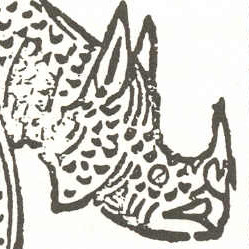January 1516 – the rhino famous from Durer’s illustration drowns in the Mediterranean
Whales as oil wells
Modern life relies heavily on oil. We use it to power our vehicles, and use the gas that collects above it to heat our homes. We make plastics from it. Yet the first oil well was drilled in only 1859. Before that, people collected oil at ‘seeps’ where it appears above ground — and they…
Where the streets were paved with gold
You might have heard of people in the past moving to places (usually London) where the streets were said to be ‘paved with gold’. It meant that anyone could be rich there. Gold would not make good actual paving. But there was once somewhere the streets really were — accidentally — paved with gold. It…
Pelicans and disabled cranes
The English diarist John Evelyn records a visit he made to James’ Park in London on 9th February 1665 where he saw many birds. One was a pelican, a gift from the Russian ambassador to London: “I examin’d the Throate of the Onocratylus or Pelecan, the tongue scarce appearing, the [B]eake above 2 foote long,…
Fish from nowhere?
Where do fish come from? That might seem a stupid question, but when a new pool forms, unconnected to any rivers, fish sometimes appear, seemingly from nowhere. Nobody has put fish in the pool. The pool is not connected with any other waterways that have fish. Yet after a few months or years, there are…
Living in the dung, looking at the stars
Dung beetles don’t have a glamorous life. They eat and often live in dung. They spend their days (or nights) finding dung dropped by a larger animal, rolling chunks of it into balls, and then bowling the balls home to their underground tunnels. Don’t under-estimate them — we would be knee-deep in unspeakable muck if…
A story in earwax
We all get earwax, even whales. But whales don’t have fingers or doctors with syringes and so their earwax stays there, building up, year after year. Yuk, you might think. But we can learn a lot from whales’ earwax. The wax accumulates into a long plug which is trapped inside the whale’s head. It builds…
Eighty percent of the nitrogen in you came from a chemical factory
Have you ever wondered how the world could suddenly support so many people? In 1900 there were 1.6 billion people and now there are 7 billion. How can we make enough food for them? The answer is a ground-breaking chemical process called the Haber process. It doesn’t sound that interesting – it takes nitrogen from…
Sellotape, pencils and a Nobel prize
You might think you need lots of clever kit and a large research team to win a Nobel prize these days. But Andre Geim and Konstantin Novoselov did it with just pencil lead and some sellotape. Well, nearly. They won the Nobel Prize for Physics, 2010, for playing with their sticky tape dispenser and producing…
Messing up the world for 2,500 years
We hear a lot about pollution and particularly what we are doing to the atmosphere. It seems we have been doing it for a very long time. Ice core samples from Greenland show raised levels of lead in the atmosphere beginning around 500BC. This is the earliest evidence of anthropogenic (human-caused) pollution. It was produced…
Snot-ites and space snot
Imagine: you go into a deep, dark cave and your hand touches slime. Then you find there is slime dripping from the roof – slime like snot. Eurgh! It’s like something from a horror movie. But it’s real. You’re in a cave festooned with snot-ites. Snot-ites are long, gooey drips of snot-like slime that hang…
Dust-bunnies and stardust
Maybe you live in a super-clean house, but I don’t. If you look under the (my) sofa or bed you will see little clusters of fluff hiding there. (It’s easier to find these if you don’t have carpets.) They’re dust-bunnies. Dust-bunnies are clumps of all kinds of detritus (waste and grunge) that has drifted around…
Do you speak mushroom? It’s the language of the worldwide wood
If you’ve see the film Avatar, you might remember that the forest is a living being, with the plants able to communicate with one another. It’s not just a sci-fi fantasy, though. Researchers found that the trees in a forest in Canada really do cooperate and communicate. They share resources and look out for one…
